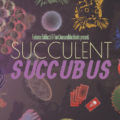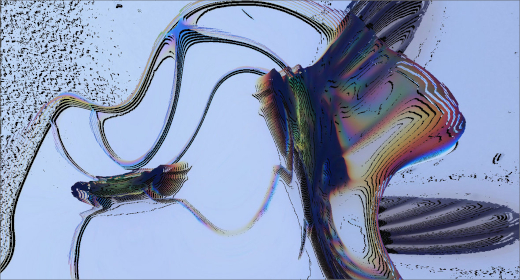A double album compilation of experimental, electronic, avant-garde, improvised, and ambient music, celebrating 3 years of Difficult Art (and music).
An anthology of difficult sound events
An anthology of difficult sound events from artists located in such places as Puerto Rico, Montreal, Trumansburg, Lewes, London, Berlin, Cornwall, as well as some unspecified places, and the soundforms range from field collages to spoken poetics and unusual electronic signals. There are some traditional music forms here too, the point is to dare you to listen to something electronic in nature that is not fitting into the usual same old same old. This is a showcase anthology of difficult art. This collection does not try to be a cohesive flowing album, these are singular items stitched together. This collection of sound events is challenging and sometimes even funny, some is probably going to be connecting with you and some is not.
On I Only Like Difficult Art (and music) the flow goes in various other directions, from long-form drone and ambient works, irreverent collages, to the likes of classical minimalism and aggressive modular synthesis, spacey at times and sometimes coming at you as rapid fire. Now stand up straight, head forward, arms ready for anything. Usually there is some detail of exquisite pain involved, perhaps that is also why you are here. I am usually wrong when I guess about instrumentation, so I will try and stick to the sound feelings, this is starting off nervous and interesting…
Disc 1 ::
Now we have come to detonate this experience. “Kor Elow” : J.Lynch (2:55), starts us off with chopped bits of percussive sound events and electronic beeps plus a banjo, arranged into some rapid bumpy episodes. J.Lynch’s music falls awkwardly between electronica, concréte, electro-acoustic, kraut, and drone music with a particular interest in lower fidelities, distortion and haptic, gestural live playing rather than sequenced patterns. J.Lynch is the name for the electronic music of Johny Lamb. Johny studied art at Dartington College of Arts and visual / performance art heavily informs his methods here. Johny lectures in Music at Falmouth University and lives in West Cornwall. He is better known for his songwriting output under the name Thirty Pounds of Bone, which he has been releasing music as, with consistent critical praise, since 2006. In this guise he is able to explore further his ever-growing fascination with modular synthesis, tape, noise, and music that doesn’t necessarily fall under the popular music umbrella.
Entering complex clouds of excellent slow atmospheric/dramatic mix of strings and electronics, flowing slowly as we experience “Removing The Veil From Their Eyes” : Federico Balducci & fourthousandblackbirds (3:58). Exploring Albert Camus’ Myth of Sisyphus and the philosophy of absurdism, the duo of Federico Balducci & fourthousandblackbirds question human existence through modes of deconstruction and re-creation that is evident in their invocative sound world. What at times feels like the lost soundtrack to an art-house horror flick, at others comes across like an introspective time for death and rebirth through philosophical drone. Melding occult field-recordings with bone-shattering synthesis, the listening experience casts an ominous air, a world filled with the fractured snippets of digital strings and orphaned voices. It’s decidedly macabre stuff, though pleasingly contemplative: contrasting layers of ambiance and distortion are masterfully weaved together to create a work that is beautiful as often as it’s uncomfortable.
Now Dr. Jumand takes us on a narrated experience haunted by low key hums and burbling glugs, bumpy string drones under the voice, “Campfire Orb (extract)” : Witch on Horseback (5:46) Now we are embarking on a new psychosomatic journey into the realm of heavy conscious synthtropics, a world of ambient tones and pulsing drones, abstract alien textures and hauntological discovery, all framed by the mesmerising voice of your host, Dr. Jumand.
The Witch on Horseback Institute for Cognitive Salubrity was a short-lived new age education center and performance space founded in Trumansburg, New York in the nineteen-seventies by former employees of the Moog synthesizer company. These forgotten recordings with disgraced Ithaca experimental psychologist Noving Jumand were discovered at a library sale in Ithaca, New York in the early 2020s, and have been restored from the original LPs by the musical entity known as Witch on Horseback, named in the Institute’s honor.
If, according to Pierre Schaffer, ”the only difference between music and noise is the intention,” then both radio signals and musical sounds can be decontextualized and coerced in a difficult environment, trying to rebuild that aural soundscape that accompanied me back then, in a dialogue which is not yet sound art, nor is radio art, floating in between this and more. Here “The Mezzotint” : Chelidon Frame (5:56) presents new legions of drones and bubbles crackling, dreamy and slow moving with shudders, there is a fantastic monster calling me to dance, should I go?
The intensity increases and the monster dances funny, according to the notes shared by the composer, Chelidon Frame: “my research was only to gather new material to use in my sound practice, after the first days of COVID confinement, all those far away radio stations became a way to plunge myself into a new dimension, where nostalgia, absence, distance, and presence lived together.”
Daniel Alexander Hignell-Tully is also a composer, performance artist, and researcher, from Lewes, UK. He holds a PhD in composition and has previously released work on Waxing Crescent, Triple Bath and DAAM.“Negotiations #1” : Daniel Alexander Hignell-Tully (3:39) brings strings and imaginary choirs to form complex court music, formal drama knows many faces, changing into a piano with extras, deep under the sea, to “Study for Pylons and Abandoned Piano” : Will Parker (6:47) where I imagine an abandoned tower structure and the sound of a purring lathe, crafting tension deep and dark with haunting signals, beep drones and things get rather dramatic as the scene builds for a spell and then calms as if to return to the gentle buzzing lathes. Something is being counted, elements are adding up, but the footsteps are not getting closer, they continue to be very steady. The piano has been understated (at times actually drilling into the wooden frame?) this is the best ghost atmosphere so far, transforming unexplained sounds in a steady flow.
Incorporating electronic experimental drone field recordings modern classical modular sound art techno field recordings, drones, drum machines, manipulated vocal processing, and found sounds, “Live to Tape (redux)” : Distant Animals (3:42) brings a caustic electro boogie bounce that sometimes increases in complexity. The beat gets stronger while the tempo goes through changes, there are no drones. Here are modular synthesis, harmonium, field-recordings, vocals, sampling, percussion and electro-acoustic processing and composed on an analog modular synthesizer and recorded directly to 4-track tape and this experience was composed, mixed and mastered by Daniel Alexander Hignell-Tully.
As nobuka, Michel van Collenburg makes experimental, lo-fi electronic music. Working from a DIY mentality with field recordings, tape recorders, modular and other analog equipment. Musically he’s influenced by Ryuichi Sakamoto, Thom Yorke, Mica Levi, Machinefabriek and Jim O’Rourke. Lately he’s been spotted diving into a musique concrete, modern composition and free-jazz rabbit hole. Outside of music he finds inspiration in the works of Haruki Murakami, Charles Bukowski, Daido Moriyama and Francesca Woodman. In his live performances he aims to create meditative soundscapes that have often been described as hypnotic and cinematographic. Witness “Veculer” – Nobuka (7:49), a collage with a piano in the dark, fitting pieces together. I suspect that there are other forces here besides the piano but the darkness hides everything. The ghosts arrive as promised, and the whole feeling gets busy. Lots of instruments including strings and woodwinds begin to move in my mind. Let us leave it there for now.
Disc 2 ::
Opens with “Tactics Faculty (extract)” : Polygone (5:42) and imagine a closed chain of ringing power electronics breaking into new forms. The complexity increases as our train hums, rattles and vibrates along. Soon the dream takes over and we are traveling into dangerous territory. I almost fell off of the train but things turned out just fine.
Formed in late 1988, Polygone operated in a strange and unwieldy domain — equally inspired by the likes of Brian Eno as they were Throbbing Gristle, the group emerged as part of the UK’s burgeoning free-party scene, serving as the ‘house band’ for a notorious Totnes party site. Living and working on a Devonshire farm – one of two sites frequented by the dedicated local rave scene — the group played hundreds of shows over six years, always wheeling out their odd brand of mellow, dream-like electronic music to straggling party-goers after the Acid DJ’s had finally turned in for the night. Mixing sampled grooves stolen from ‘world’ music anthologies with live instrumentation – notably manipulated vocals and distorted guitars – and integrating semi-ironic takes on whatever was currently riding the charts (Sinead O’Connor being a particular favorite), the group preempted much of the ambient electronic music that would emerge in the decades that followed.
Ponder the wisdom of Nikola Tesla, “If you want to find the secrets of the universe, think in terms of energy, frequency and vibration.” Allow yourself to be drawn into the subtle undulating layers as they resonate from the energies traversing our earth atmosphere and be rewarded with an experience through each of their journeys; listening to this track from start to finish, you may hear something new within each time. “Symphonie des Machines (part 1)” : Arvik Torrenssen (3:55) featuring dark spooky struck strings. I am trying to keep the old dolls inside their boxes while the intensity builds with hardly a round wheel to be heard, but none of these robots are dangerous. Atmospheric soundscapes using environmental and atmospheric data to create generative and modify evolving ambient pieces. They have designed and constructed a hybrid modular electronic music system. Based in London & Bristol, UK, “we specialize in layered ambient music & psyco-acoustic audio concepting.” According to what I remember from the notes, we might hear 434 MHz FM (VHF) domestic machine to machine; car fobs, weather stations, monitors, IoT devices; a wave table was captured and then triggered when signals were detected; minimal reverb to add spaciousness.
David Curington’s music has been featured on Freeness on BBC Radio 3 and he is a former winner of the RPS Composition Prize. David is the founder of record label Square Ears and his debut cassette mind maps (SQE001) was released on Square Ears in 2021 and he has performed as an improviser at both label nights and the Curious Ear series based in Manchester. His second cassette THE WAY (SQE003) was also released on Square Ears, in September 2022. “BUY THIS THING” : David Currington (9:28) presents a disruptive, intelligent and well executed listening event, a bit busy with overwhelming word collages. Here things are layered, a woman explains everything fairly well and more than one mumbling man just goes on and on, the dynamics flex in places, so many voices speaking. Like a poetic orchestra. There is a grocery theme to this ordeal. You will never sleep again.
David Curington is a composer, improvising oboist and abstract photographer based in Manchester, UK, who adopts similar aesthetics and processes for creating densely layered and immersive textures in both his music and visual art. Trained as a classical composer and oboist, he obtained a PhD in composition from the Royal Northern College of Music and his interests to date have included noise, improvisation, failure, complexity, iterative processes, non- linear modes of listening, abstract expressionism, collage and reconceptualising the oboe.
Born in London to mixed Indian/British heritage, Simon McCorry studied music at The Centre for Young Musicians and Morley College, then philosophy at Durham University, and is now based in Stroud, Gloucestershire. Simon has worked as a composer and sound designer in theatre, film and contemporary dance. His recent work is a combination of loop-based cello compositions and atmospheric improvisations, field recordings and modular synth. “Storm” : Simon McCorry (10:11) comes fluttering in dangerously, chaotic and kinetic while things get really stressed until it fades onto a tense peace on the edge where the suspense grabs you. Later things get fully peaceful, quite a contrast. I hear one long high pitched string tone supports the darkest night until the quiet slowly wins and the dark takes all.
DOL FAM is an experimental art project, mostly working w/ sound, but at times presenting performance art, abstract theatre, spoken-word, and multi-media happenings. It’s primarily the brainchild of Fidge Bibblyotek, but in a live setting they often collaborate with S. Crouton, Stu Chaney, and Gabriel Pentin. “Homages 2 (extract)” : Dol Fam (3:56) is where I hear a piano making loop forms, looping minimalism, loops that fit hours and days, weeks, centuries into just under 4 minutes, now count with me.
Fidge Bibblyotek is an autistic, queer, outsider artist, musician, poet, anarcho-communist, scholar, zine editor, event promoter, and punk rocker. He read International Politics at Portsmouth followed by an MA in Social and Political Thought at Sussex. His academic work was mainly focused on libertarian socialism. Fidge’s MA thesis was on punk rock, anarchism, and the continued importance of DIY cultural activity. Fidge plays guitar and/or sings in several post-punk bands; Austerity, Mules, and Grunt Work. He puts out NEVER WORK, a crypto-situationist zine, and he is one third of FLIM FLAM; a Dada-influenced club-night. He also runs Can’t Cheat Karma; a DIY tape label and zine press, and he occasionally puts on punk shows as part of Better Off Dead collective. Fidge’s solo projects include /./:././:/ (electronic post-punk), F. Neechee (minimalist dubstep/drone), and Tommy Comstock (anti-folk/folk-punk). Fidge lives and works in Brighton where he spends the majority of his time meditating, eating burritos, kitchen-dancing to Le Tigre, smoking pot, and binge-watching cartoons.
John Garner plays violin, mandolin, flutes, harmonica, percussions and John Pope also can be heard on double bass, Bass VI, electronics, percussions, here the track is a “Soundcheck (ft. John Pope)” : John Garner (5:42) where we fade into a slow jazz construction site with heavy instruments way out there. The feeling is delicate from my listening perspective which makes this easier to listen to after what we just went through. All the instruments are blowing free but at a very reduced volume emphasizing those hot edges. I hear styles as diverse as jazz, folk, and punk rock. Their shared love of improvised musical forms allows them to unearth a common and evolving language from moment to moment.
Felipe Vaz is a Brazilian sound artist and composer living in Berlin. Most of his works investigate temporal processes and either conceptual or spatial issues related to sound and music, and his installations and his music have been presented in galleries and shows such as Casa Encendida (Madrid), Acud Macht Neu and Transmediale Vorspiel (Berlin), Novas Frequências (Rio de Janeiro) among many others. “The Well Frozen Piano (extract)” : Felipe Vaz (6:23) has a very slow fade in, this could qualify as sleep music, low key gentle and sweet, various drones fade in and this is what I like most about anthologies, it’s good to mix things up and to be widely inclusive in modality. Vaz holds a master’s degree from UdK Berlin, and recently received a Musikfonds grant for an ongoing research on composition using animated graphic notation. His music has been released on New York Haunted (NL), Differ Records (SE) and others.
Now we go to the “Tactics Faculty (‘Edge of Chaos’ remix)” : Finlay Wright (6:16), seeming to be gentle and peaceful, orchestral reed and air instrument sounds, the chaos is slow to arrive. The mood could be celestial in scope, it gets stranger as we go through some chaos into the dreamy places. Listen for the AB Spectral sonics that sound like time is moving all around you as you pace out (and navigate) past, present and future sonic paths in the radio spectrum.
Under the name Heavy Cloud, Cornwall-based Ryan Hooper creates music inspired by memory and internal and external landscapes, often in tandem with collage-based artworks and textual explorations. “Lux Brumalis” : Heavy Cloud (5:00) To me, this feels like winter light might feel, a glowing celestial blend of wind reed instrument drones. Now things increase until we are eaten by dark monsters in the end.
Tracklist ::
DISC 1, LP:
J.Lynch :: “Kor Elow”
Federico_Balducci & fourthousandblackbirds :: “Removing the Veil From Their Eyes”
Warren Rasmussen :: “Mazda Bongo Dream Potato”
Witch on Horseback :: “Campfire Orb (extract)”
Chelidon Frame :: “The Mezzotint”
Daniel Alexander Hignell-Tully :: “Fisherfolk, Fantasists, Foreigners”
Will Parker :: “Study for Pylons and Abandoned Piano”
Distant Animals :: “Live to Tape”
DISC 2, CD:
Polygone :: “Tactics Faculty (extract)”
Arvik Torrenssen :: “Seppäeraa”
Simon McCorry :: “Storm”
John Garner :: “Soundcheck (ft. John Pope)”
Nobuka :: “Veculer”
Felipe Vaz :: “The Well Frozen Piano (extract)”
David Curington :: “BUY THIS THING”
Heavy Cloud :: “Lux Brumalis”
I Only Like Difficult Art (and music) is available on Difficult Art (and music).






















![Luke’s Anger :: Ceiling Walker EP (Love Love) — [concise]](https://igloomag.com/wp/wp-content/uploads/2025/04/lukes-anger-ceiling-walker-vinyl_feat-75x75.jpg)

![Ndorfik & madebyitself :: Solos EP (People Can Listen) — [concise]](https://igloomag.com/wp/wp-content/uploads/2025/04/ndorfik-madebyitself-solos_feat-75x75.jpg)




